Introduction: In recent years, the application fields of hose packaging have gradually expanded. Industrial supplies choose hoses, such as lubricating oil, glass glue, caulking glue, etc.; food chooses hoses, such as mustard, chili sauce, etc.; pharmaceutical ointments choose hoses, and the tube packaging of toothpaste is also constantly upgraded. More and more products in different fields are packaged in "tubes". In the cosmetics industry, hoses are easy to squeeze and use, light and portable, have customized specifications, and are customized for printing. They are used in cosmetics, daily necessities, Products such as cleaning products are very fond of using cosmetic tube packaging.
product definition
Hose is a kind of packaging container based on PE plastic, aluminum foil, plastic film and other materials. It is made into sheets using co-extrusion and compounding processes, and then processed into a tubular shape by a special pipe-making machine. The hose is light in weight and easy to use. It is favored by many cosmetics manufacturers due to its characteristics such as portability, durability, recyclability, easy squeezing, processing performance and printing adaptability.
Manufacturing process
1. Molding process
A、Aluminum-plastic composite hose
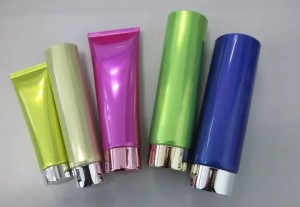
Aluminum-plastic composite hose is a packaging container made of aluminum foil and plastic film through co-extrusion compounding process, and then processed into a tubular shape by a special pipe-making machine. Its typical structure is PE/PE+EAA/AL/PE +EAA/PE. Aluminum-plastic composite hoses are mainly used for packaging cosmetics that require high hygiene and barrier properties. The barrier layer is generally aluminum foil, and its barrier properties depend on the pinhole degree of the aluminum foil. With the continuous improvement of technology, the thickness of the aluminum foil barrier layer in aluminum-plastic composite hoses has been reduced from the traditional 40 μm to 12 μm or even 9 μm, which greatly saves resources.
B. Full plastic composite hose
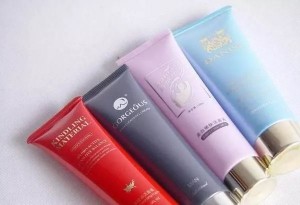
All plastic components are divided into two types: all-plastic non-barrier composite hoses and all-plastic barrier composite hoses. All-plastic non-barrier composite hoses are generally used for packaging of low-end, fast-consuming cosmetics; all-plastic barrier composite hoses are usually used for mid- to low-end cosmetics packaging due to side seams in pipe making. The barrier layer can be EVOH, PVDC, or oxide coatings. Multi-layer composite materials such as PET. The typical structure of all-plastic barrier composite hose is PE/PE/EVOH/PE/PE.
C. Plastic co-extruded hose
Co-extrusion technology is used to co-extrude raw materials with different properties and types together and form them in one go. Plastic co-extruded hoses are divided into single-layer extruded hoses and multi-layer co-extruded hoses. The former is mainly used for fast-consuming cosmetics (such as hand cream, etc.) that have high requirements on appearance but low actual performance requirements. Packaging, the latter is mainly used for packaging of high-end cosmetics.
2. Surface treatment
The hose can be made into colored tubes, transparent tubes, colored or transparent frosted tubes, pearlescent tubes (pearlescent, scattered silver pearlescent, scattered gold pearlescent), and can be divided into UV, matte or bright. Matte looks elegant but is easy to get dirty, and colored The difference between the tube and the large-area printing on the tube body can be judged from the incision at the tail. The tube with a white incision is a large-area printing tube. The ink used must be high, otherwise it will easily fall off and will crack and reveal white marks after being folded.
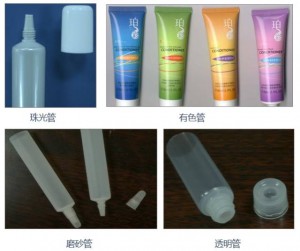
3. Graphic printing
Commonly used methods on the surface of hoses include silk screen printing (using spot colors, small and few color blocks, the same as plastic bottle printing, requiring color registration, commonly used in professional line products), and offset printing (similar to paper printing, with large color blocks and many colors). , commonly used in daily chemical line products), as well as hot stamping and silver hot stamping. Offset printing (OFFSET) is usually used for hose processing. Most of the inks used are UV-dried. It usually requires the ink to have strong adhesion and resistance to discoloration. The printing color should be within the specified shade range, the overprinting position should be accurate, the deviation should be within 0.2mm, and the font should be complete and clear.
The main part of the plastic hose includes the shoulder, tube (tube body) and tube tail. The tube part is often decorated through direct printing or self-adhesive labels to carry text or pattern information and enhance the value of product packaging. The decoration of hoses is currently mainly achieved through direct printing and self-adhesive labels. Direct printing includes screen printing and offset printing. Compared with direct printing, the advantages of self-adhesive labels include: Printing diversity and stability: The process of making traditional extruded hoses first and then printing usually uses offset printing and screen printing, while self-adhesive printing can use letterpress , flexographic printing, offset printing, screen printing, hot stamping and other diversified combined printing processes, the difficult color performance is more stable and excellent.
1. Pipe body
A. Classification

According to material: aluminum-plastic composite hose, all-plastic hose, paper-plastic hose, high-gloss aluminum-plated pipe, etc.
According to thickness: single-layer pipe, double-layer pipe, five-layer composite pipe, etc.
According to tube shape: round hose, oval tube, flat hose, etc.
According to application: facial cleanser tube, BB box tube, hand cream tube, hand remover tube, sunscreen tube, toothpaste tube, conditioner tube, hair dye tube, facial mask tube, etc.
Conventional pipe diameter: Φ13, Φ16, Φ19, Φ22, Φ25, Φ28, Φ30, Φ33, Φ35, Φ38, Φ40, Φ45, Φ50, Φ55, Φ60
Regular capacity:
3G, 5G, 8G, 10G, 15G, 20G, 25G, 30G, 35G, 40G, 45G, 50G, 60G, 80G, 100G, 110G, 120G, 130G, 150G, 180G, 200G, 250G, 250G
B. Hose size and volume reference
During the production process of hoses, they will be exposed to "heating" processes many times, such as pipe drawing, jointing, glazing, offset printing and screen printing drying. After these processes, the size of the product will be adjusted to a certain extent. The shrinkage and "shrinkage rate" will not be the same, so it is normal for the pipe diameter and pipe length to be within a range.
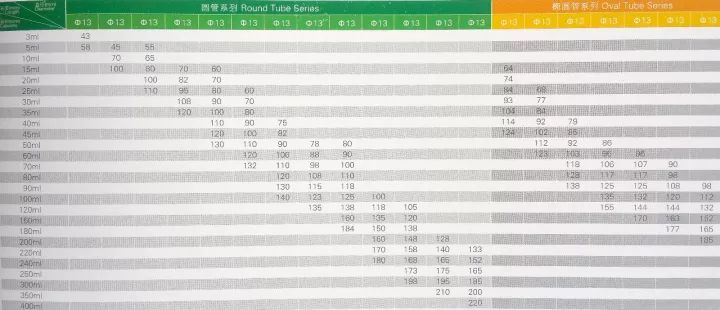
C. Case: Schematic diagram of five-layer plastic composite hose structure
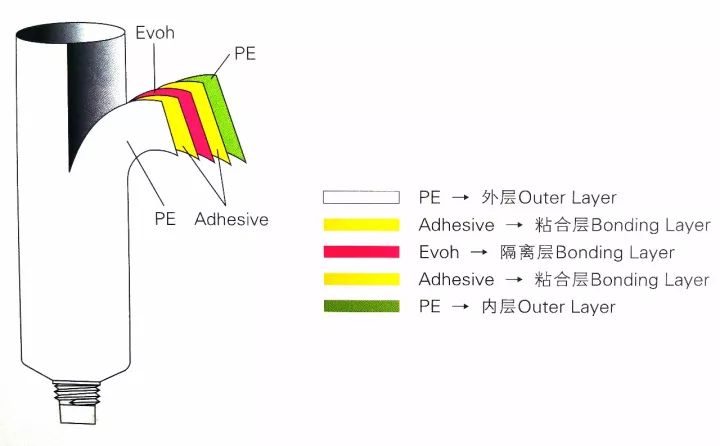
2. Tube tail
Some products need to be filled before sealing. The sealing can be divided into: straight sealing, twill sealing, umbrella-shaped sealing, and special-shaped sealing. When sealing, you can ask to print out the required information at the sealing place. Date code.
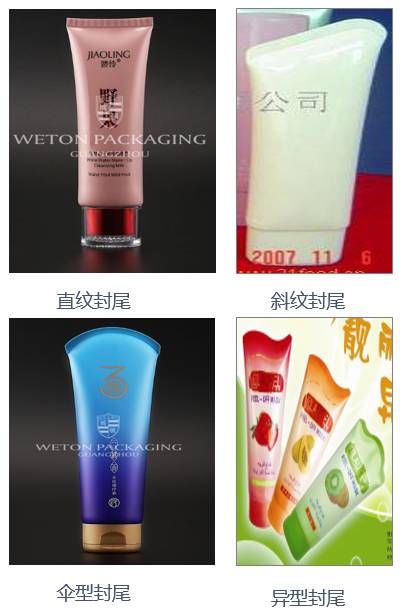
3. Supporting equipment
A. Regular packages
Hose caps come in various shapes, generally divided into screw caps (single-layer and double-layer, the double-layer outer caps are mostly electroplated caps to increase product quality and look more beautiful, and professional lines mostly use screw caps), flat caps , round head cover, nozzle cover, flip-up cover, super flat cover, double-layer cover, spherical cover, lipstick cover, plastic cover can also be processed in a variety of processes, hot stamping edge, silver edge, colored cover, transparent, oil spray, Electroplating, etc., tip caps and lipstick caps are usually equipped with inner plugs. The hose cover is an injection molded product and the hose is a drawn tube. Most hose manufacturers do not produce hose covers themselves.
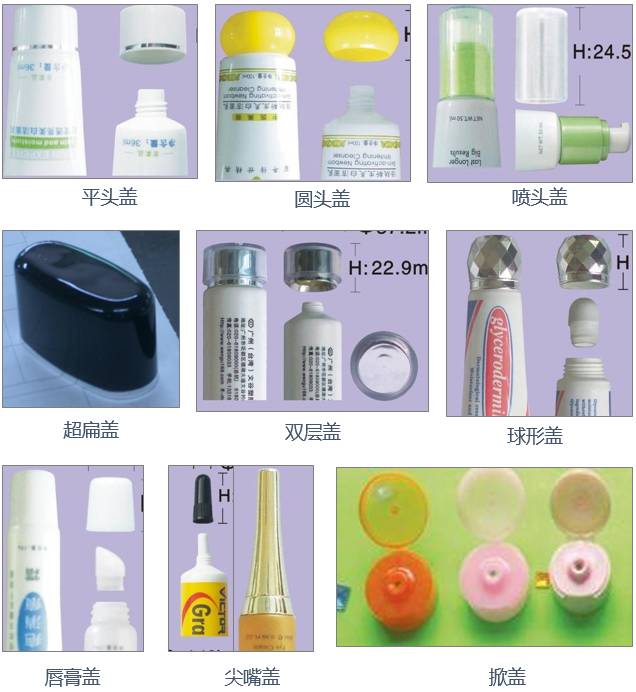
B. Multifunctional supporting equipment
With the diversification of user needs, the effective integration of content and functional structure, such as massage heads, balls, rollers, etc., has also become a new demand in the market.
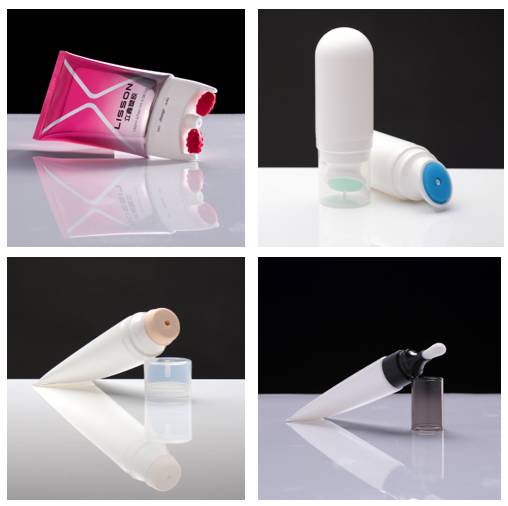
Cosmetic applications
The hose has the characteristics of light weight, easy to carry, strong and durable, recyclable, easy to squeeze, good processing performance and printing adaptability. It is favored by many cosmetics manufacturers and is widely used in cleansing products (face wash, etc.) and skin care products. In the packaging of cosmetics (various eye creams, moisturizers, nutritional creams, creams, sunscreens, etc.) and beauty and hair care products (shampoo, conditioner, lipstick, etc.).
Procurement key points
1. Review of hose design drawings

For people who are not familiar with hoses, designing the artwork on your own can be a heart-wrenching problem, and if you make a mistake, everything will be ruined. High-quality suppliers will design relatively simple drawings for those who are not familiar with hoses. After the pipe diameter and pipe length are determined, they will then provide a design area diagram. You only need to place the design content in the diagram area and center it. That's it. High-quality suppliers will also inspect and advise on your design and production processes. For example, if the position of the electric eye is wrong, they will tell you; if the color is not reasonable, they will remind you; if the specifications do not meet the design, they will remind you repeatedly to change the artwork; and if the barcode direction and readability are qualified, color separation and High-quality suppliers will check for you one by one whether there are small errors such as whether the process can produce a hose or even if the drawing is not twisted.
2. Selection of pipe materials:
The materials used must meet relevant health standards, and harmful substances such as heavy metals and fluorescent agents should be controlled within specified limits. For example, the polyethylene (PE) and polypropylene (PP) used in hoses exported to the United States must meet the U.S. Food and Drug Administration (FDA) standard 21CFR117.1520.
3. Understand filling methods
There are two methods of hose filling: tail filling and mouth filling. If it is pipe filling, you should pay attention when purchasing the hose. You must consider whether the "size of the pipe mouth and the size of the filling nozzle" match and whether it can be flexibly extended into the pipe. If it is filling at the end of the tube, then you need to arrange the hose, and at the same time consider the head and tail direction of the product, so as to make it convenient and fast to enter the tube during filling. Secondly, you need to know whether the contents during filling are "hot filling" or at room temperature. In addition, the process of this product is often related to the design. Only by understanding the nature of filling production in advance can we avoid problems and achieve high production and efficiency.
4. Hose selection
If the contents packaged by a daily chemical company are products that are particularly sensitive to oxygen (such as some whitening cosmetics) or have very volatile fragrances (such as essential oils or some oils, acids, salts and other corrosive chemicals), then Five-layer co-extruded pipe should be used. Because the oxygen transmission rate of five-layer co-extruded pipe (polyethylene/bonding resin/EVOH/bonding resin/polyethylene) is 0.2-1.2 units, while the oxygen transmission rate of ordinary polyethylene single-layer pipe is 150- 300 units. Within a certain period of time, the weight loss rate of co-extruded tubes containing ethanol is dozens of times lower than that of single-layer tubes. In addition, EVOH is an ethylene-vinyl alcohol copolymer with excellent barrier properties and fragrance retention (the thickness is optimal when it is 15-20 microns).
5. Price description
There is a big difference in price between hose quality and manufacturer. The plate making fee is usually 200 yuan to 300 yuan. The tube body can be printed with multi-color printing and silk screen. Some manufacturers have thermal transfer printing equipment and technology. Hot stamping and silver hot stamping are calculated based on unit price per area. Silk screen printing has better effect but is more expensive and there are fewer manufacturers. Different manufacturers should be selected according to different levels of needs.
6. Hose production cycle
Generally, the cycle time is 15 to 20 days (from the time of confirming the sample tube). The order quantity of a single product is 5,000 to 10,000. Large-scale manufacturers usually set a minimum order quantity of 10,000. Very few small manufacturers have a large number of varieties. The minimum order quantity of 3,000 per product is also acceptable. Very few customers open molds by themselves. Most of them are public molds (a few special lids are private molds). The contract order quantity and the actual supply quantity are ±10 in this industry. % deviation.
Product show
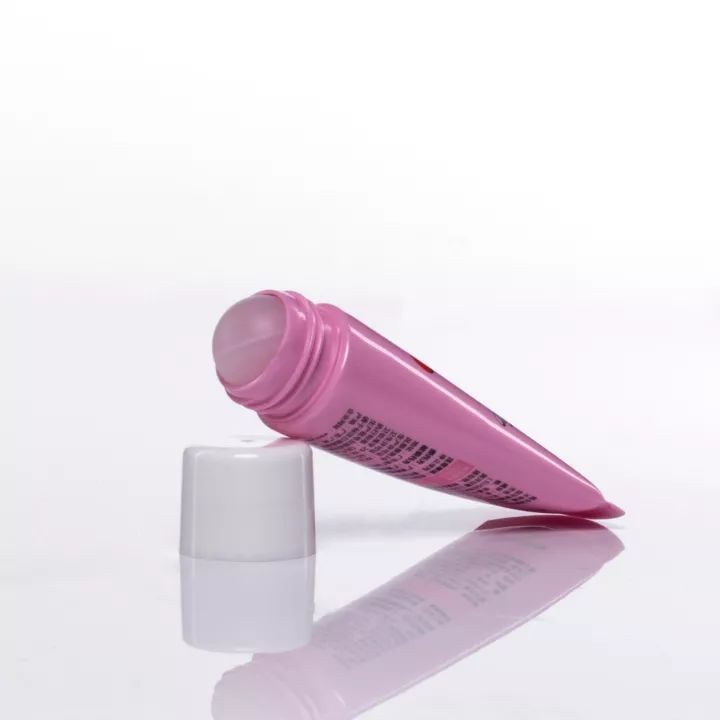
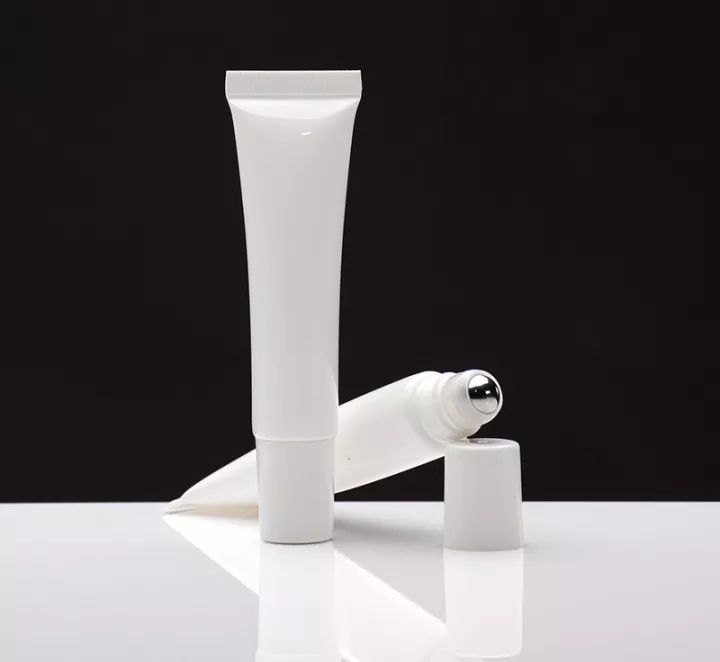
Post time: Apr-30-2024

